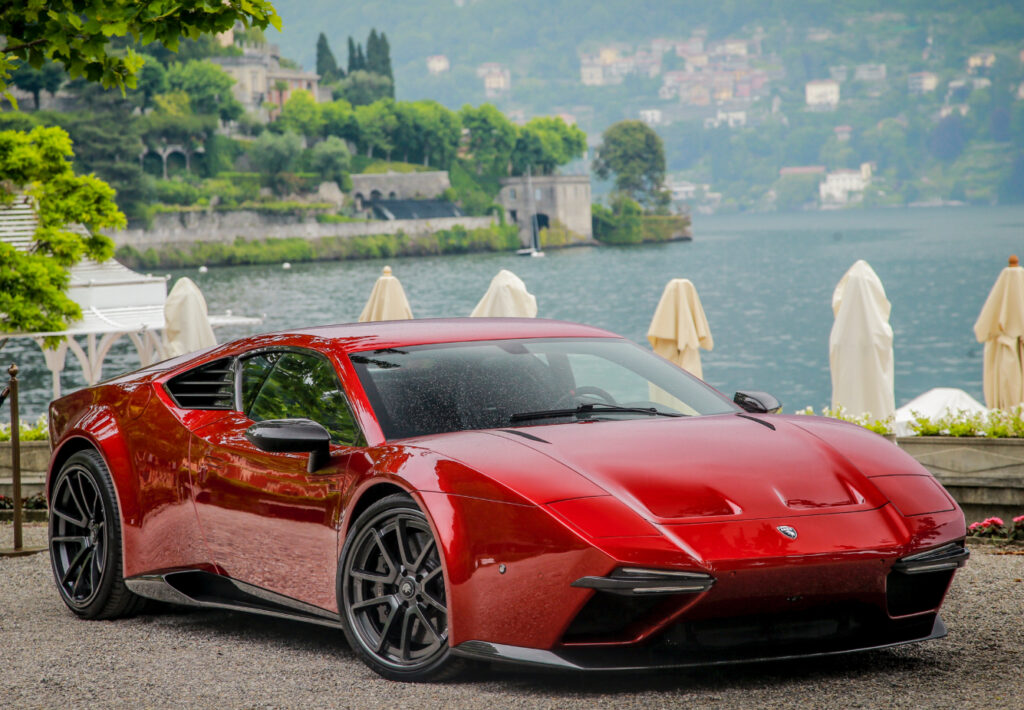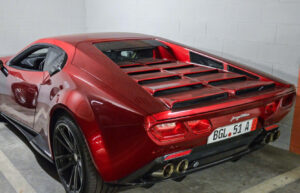

A Glimpse at Modern Mythology
The ARES Panther ProgettoUno is not merely a car—it’s a resurrection. A car of mythic lineage, breathing new life into the cult-classic De Tomaso Pantera, the Panther is ARES Modena’s reinterpretation of what a 1970s poster car would look and feel like if it were born into the modern supercar age. Crafted in Italy with obsessive attention to detail, the Panther is raw yet refined, analog in soul but digital in precision. This drive review is not just about power or specs—it’s about how memory, motion, and modernity converge in one of the most captivating bespoke automobiles on the planet.
Backstory: A Modern Ode to the Pantera
The original De Tomaso Pantera—a wedge-shaped predator from the early 1970s—represented an unlikely blend of American brawn and Italian elegance. Powered by Ford-sourced V8s but styled by Ghia and built in Modena, the Pantera earned its status as a rebellious exotic. But like all cult heroes, its story ended too soon.
Fast-forward to 2020, when ARES Design, under the leadership of former Lotus CEO Dany Bahar, unveiled the Panther ProgettoUno—a project that would not just revive the Pantera’s DNA but evolve it into a thoroughly modern, coachbuilt supercar. And yet, even in its modern guise, the Panther insists on channeling the muscular stance, sharp angles, and unfiltered drama of its ancestor.
Design: Neo-Retro, Reimagined to Perfection
Before you even touch the start button, the ARES Panther stuns. Low, wide, and aggressive, the car wears its retro-futurism like armor. The front fascia is a nod to the original Pantera’s pop-up headlights, updated with slim LED strips and retractable mechanisms that evoke childlike nostalgia.
Flowing side air intakes and staggered wheels wrapped in Michelin Pilot Sport Cup 2s add to the Panther’s athletic posture, while a carbon-fiber bodywork glistens in metallic paint finishes that accentuate every razor-sharp crease. The rear—sculptural and feral—features Y-shaped LED taillights and quad titanium exhaust tips that snarl when provoked.
While most modern supercars chase fluidity or technical reductionism, the Panther asserts itself. It doesn’t whisper; it growls design from every angle.
Interior: Italian Tailoring Meets Supercar Theater
Step inside, and you’re greeted by a cockpit that refuses to compromise comfort for drama. It’s low-slung and immersive, with hand-stitched leather, Alcantara panels, and forged carbon trim everywhere you look. The seats, custom-molded to your dimensions, provide both touring comfort and track-worthy support.
Unlike many cars of its caliber, the Panther does not let screens dominate the cabin. While a center touchscreen handles infotainment and telemetry, physical toggles, dials, and fighter-jet-style switches provide the tactility often missing in today’s digital-first interiors.
Ares allows full customization of the cabin—color palettes, materials, embroideries—so no two Panthers are alike. The version we drove came in oxblood leather and brushed aluminum with yellow accents—a stunning combination that balanced opulence with aggression.
Under the Skin: A Lamborghini Heartbeat
Mechanically, the Panther ProgettoUno is based on the Lamborghini Huracán—specifically the Huracán LP610-4—though you’d never suspect it from the outside. The donor car provides more than a foundation; it contributes the ferocious 5.2L naturally aspirated V10, mated to a 7-speed dual-clutch transmission and an all-wheel-drive system that keeps the Panther razor-sharp even at the limits.
But this is no simple rebadge. ARES completely re-tunes the ECU, recalibrates the transmission for more aggressive downshifts, and equips a bespoke exhaust system that transforms the V10 into a roaring operatic force of nature.
Power output: 650 horsepower
0–100 km/h (0–62 mph): 3.1 seconds
Top speed: over 325 km/h (202 mph)
What makes this car special, however, is not numbers—it’s character. The Panther doesn’t chase lap times; it hunts experiences.
The Drive: Raw, Precise, and Unforgettable
On a twisty section of the Apennine mountains, we finally let the Panther off its leash.
First impressions? Explosive throttle response and a soundtrack that reverberates through your ribcage. The V10 wails with increasing violence past 6,000 rpm, crescendoing in a banshee-like scream at redline. The titanium exhaust crackles on overrun like celebratory fireworks.
Steering is hydraulic-feel, not numb electric, offering real feedback through a perfectly contoured, leather-wrapped wheel. The chassis, tuned by ARES’ in-house dynamics team, is more compliant than the Huracán’s, thanks to softer dampers and a different tire profile, but every corner is still razor-cut.
Brakes—massive carbon-ceramics—are progressive and confident. Whether trail braking into tight hairpins or hammering down mountain descents, the car remains poised and ready.
There’s a sense of theater to every input. Each downshift feels like a cinematic moment. Each turn, an act of choreography. And yet, it never feels temperamental—only alive.
Technology vs. Emotion
What’s fascinating is how ARES strikes a balance between modern performance tech and analog engagement. There are no intrusive nannies, no multi-level drive modes that overcomplicate the experience. Yes, traction control is there, but it’s minimal. The Panther’s greatest triumph is that it trusts the driver.
In a time when artificial intelligence and driver aids mediate every millisecond, the Panther stands out as a celebration of human-machine connection. You feel the road. You command the car.
Exclusivity: The Art of Bespoke Performance
Only 21 examples of the Panther ProgettoUno will ever be made, each priced at around €500,000–€550,000 depending on customization. It’s not meant for everyone—and that’s the point. This is automotive haute couture, hand-assembled in Modena, tailored for the enthusiast who craves both style and soul.
Clients are invited to collaborate on their car’s final design, visiting the ARES Modena Atelier to select leathers, materials, colors, and performance preferences. It’s as much about the process as the product.
And that makes the Panther far more than a car—it’s a personal statement, a commissioned art piece with 650 horses underneath it.
Legacy and Context: Why the Panther Matters
The ARES Panther ProgettoUno is a time machine—not in function, but in feeling. It evokes the past without mimicking it, and advances the present without surrendering to sterility. In the broader context of automotive culture, it serves as a critique of mass production, digital overload, and emotional detachment.
In essence, it answers the question: What if we could feel again in a supercar?
By bridging eras, philosophies, and emotions, the Panther revives a kind of romanticism that’s largely been lost in the carbon-tubbed, software-optimized supercars of today.
Impression
Long after we handed back the keys and the V10’s echo faded into the hills, the Panther ProgettoUno lingered in our minds. Not because it was the fastest or most advanced machine we’ve driven—but because it was among the most soulful.
It’s loud. It’s outrageous. It’s visceral. And it’s utterly brilliant.
No comments yet.








